A Contribution to the Knowledge of Hydnum (Hydnaceae, Cantharellales) in China, Introducing a New Taxon and Amending Descriptions of Five Known Species
Abstract
1. Introduction
2. Materials and Methods
2.1. Morphological Studies
2.2. Molecular Procedures
2.3. Dataset Assembly
2.4. Phylogenetic Analyses
3. Results
3.1. Molecular Data
3.2. Taxonomy
- Other known species from China
4. Discussion
5. Conclusions
| Key to the Accepted Species of Hydnum in China | |
|---|---|
| 1. Pileus white, pale cream, cream, yellowish-white, yellowish-grey | 2 |
| 1. Pileus creamy yellow, pale orange, greyish orange, orange | 11 |
| 2. Basidiomata medium to large, pileus > 5 cm diameter | 3 |
| 2. Basidiomata small, pileus < 5 cm diameter | 6 |
| 3. Distributed in sub-alpine regions, elevation > 3000 m, pileal context changing orange-white to pale orange when injured, basidiospores larger (8–9 × 6.5–7.5 μm) | H. sinorepandum |
| 3. Distributed in subtropical/tropical regions, elevation < 2000 m, pileal context unchanging in color when injured, basidiospores smaller (up to 7 μm long and 6.5 μm wide) | 4 |
| 4. Basidiospores larger (6–7 × 5–6.5 μm), basidia longer (21–59 μm), odor sweetish and fragrant | H. treui |
| 4. Basidiospores smaller (up to 5.5 μm long and 4.5 μm wide), basidia shorter (up to 40 μm), odor indistinctive | 5 |
| 5. Stipe cream white, branched, longer (4–6 cm), spines longer (>3 cm long) | H. cremeoalbum |
| 5. Stipe white, not branched, shorter (2–3 cm), spines shorter (<3 cm long) | H. pinicola |
| 6. Context unchanging in color when injured | 7 |
| 6. Context turning red to reddish-brown when injured | H.minus |
| 7. Pileus flabelliform to semicircular, with appressed brownish-orange scales, a distribution in temperate China | H. flabellatum |
| 7. Pileus round, without scales, a distribution in subtropical China | 8 |
| 8. Pileal surface turning brownish-orange to brownish red when injured | H. microcarpum |
| 8. Pileal surface unchanging in color when injured | 9 |
| 9. Basidiospores subglobose, pileipellis composed of frequently branched hyphae | H. tenuistipitum |
| 9. Basidiospores broadly ellipsoid, pileipellis composed of occasionally to rarely branched hyphae | 10 |
| 10. Pileal surface velutinate, pure white, spines shorter (0.2–0.8 mm), basidiospores smaller (5–5.8 × 3.8–4.8 μm) | H. brevispinum |
| 10. Pileal surface glabrous, yellowish-white to yellowish-grey, spines longer (0.5–2 mm), basidiospores larger (7.2–8.8 × 5.5–6.5 μm) | H. flavidocanum |
| 11. Pileipellis a cutis, composed of interwoven to subparallel hyphae | 12 |
| 11. Pileipellis a trichoderm, composed of mostly erect hyphae | H. erectum |
| 12. Basidiomata medium to large, pileus > 5 cm diameter | 13 |
| 12. Basidiomata small, pileus < 5 cm diameter | 14 |
| 13. Basidiospores subglobose, smaller (4.5–6 × 4–5 μm), spines clearly decurrent, pileal surface cream yellow, glabrous, stipe cream white, staining reddish when handled, a distribution in tropical China | H. orientalbidum |
| 13. Basidiospores broadly ellipsoid, larger (7.2–8.8 × 5.8–7 μm), spines non-decurrent, pileal surface orange to brownish-orange, velutinate, stipe white, staining pale orange when handled, a distribution in subtropical China | H. tangerinum |
| 14. Pileal surface changing to orange-white when injured, stipe longer (>5 cm long) | H. longipes |
| 14. Pileal surface unchanging in color when injured, stipe shorter (<5 cm long) | 15 |
| 15. Spines non-decurrent, a distribution in the gymnosperm forest | 16 |
| 15. Spines subdecurrent to decurrent, a distribution in the angiosperm forest | 18 |
| 16. Pileal context white, changing pale orange when injured, basidiospores larger (8–11 × 7–10 μm) | H. melitosarx |
| 16. Pileal context yellowish-white, unchanging in color when injured, basidiospores smaller (up to 9.5 μm long and 8.5 μm) | 17 |
| 17. Pileal surface orange-white to pale orange, stipe longer (3–5.5 cm), light yellow, unchanging in color when injured, basidiospores broadly ellipsoid (7.8–9.5 × 6–7.5 μm), basidia subcylindric or subclavate | H. pallidocroceum |
| 17. Pileal surface orange, stipe shorter (3–3.5 cm), orange-white, staining brownish when handled, basidiospores subglobose (8.2–9 × 7.5–8.5 μm), basidia fusiform to subcylindric, ventricose | H. ventricosum |
| 18. Pileal surface glabrous, basidia shorter (up to 65 μm), stipe surface unchanging in color when handled, basidiospores broadly ellipsoid (Q = 1.2–1.28) | 19 |
| 18. Pileal surface subglabrous to velutinate, basidia longer (up to 82 μm), stipe surface staining pale yellow when handled, basidiospores subglobose (Q = 1.09–1.13) | H. longibasidium |
| 19. Pileus subglobose, pileal surface orange-white, stipe white, spines white, non-decurrent to subdecurrent | H. sphaericum |
| 19. Pileus irregularly round to semicircular, or infundibuliform, pileal surface orange-white to pale orange, but pileal margin whitish (obviously lighter), stipe orange white to pale orange, spines orange white to pale orange, decurrent | H. pallidomarginatum |
Author Contributions
Funding
Institutional Review Board Statement
Data Availability Statement
Acknowledgments
Conflicts of Interest
References
- Niskanen, T.; Liimatainen, K.; Nuytinck, J.; Kirk, P.; Ibarguren, I.O.; Garibay-Orijel, R.; Norvell, L.; Huhtinen, S.; Kytövuori, I.; Ruotsalainen, J.; et al. Identifying and naming the currently known diversity of the genus Hydnum, with an emphasis on European and North American taxa. Mycologia 2018, 110, 890–918. [Google Scholar] [CrossRef]
- Agerer, R.; Kraigher, H.; Javornik, B. Identification of ectomycorrhizae of Hydnum rufescens on Norway spruce and the variability of the ITS region of H. rufescens and H. repandum (Basidiomycetes). Nova Hedwig. 1996, 63, 183–194. [Google Scholar]
- Moncalvo, J.M.; Nilsson, R.H.; Koster, B.; Dunham, S.M.; Bernauer, T.; Matheny, P.B.; Porter, T.M.; Margaritescu, S.; Weiss, M.; Garnica, S.; et al. The cantharelloid clade: Dealing with incongruent gene trees and phylogenetic reconstruction methods. Mycologia 2006, 98, 937–948. [Google Scholar] [CrossRef] [PubMed]
- Swenie, R.A.; Baroni, T.J.; Matheny, P.B. Six new species and reports of Hydnum (Cantharellales) from eastern North America. MycoKeys 2018, 30, 35–72. [Google Scholar] [CrossRef] [PubMed]
- Yanaga, K.; Sotome, K.; Ushijima, S.; Maekawa, N. Hydnum species producing whitish basidiomata in Japan. Mycoscience 2015, 56, 434–442. [Google Scholar] [CrossRef]
- Hall, D.; Stuntz, D.E. Pileate Hydnaceae of the Puget Sound area. I. White-spored genera: Auriscalpium, Hericium, Dentinum and Phellodon. Mycologia 1971, 63, 937–1098. [Google Scholar] [CrossRef]
- Maas Geesteranus, R.A. Hydnaceous Fungi of the Eastern Old World; North-Holland Publishing Company: Amsterdam, The Netherlands, 1971; pp. 63–77. [Google Scholar]
- Pine, E.M.; Hibbett, D.S.; Donoghue, M.J. Phylogenetic relationships of cantharelloid and clavaroid Homobasidiomycetes based on mitochondrial and nuclear rDNA sequences. Mycologia 1999, 91, 944–963. [Google Scholar] [CrossRef]
- Feng, B.; Wang, X.H.; Ratkowsky, D.; Gates, G.; Lee, S.S.; Grebenc, T.; Yang, Z.L. Multilocus phylogenetic analyses reveal unexpected abundant diversity and significant disjunct distribution pattern of the Hedgehog Mushrooms (Hydnum L.). Sci. Rep. 2016, 6, 25586. [Google Scholar] [CrossRef] [PubMed]
- Lee, S.S.; Watling, R.; Noraini-Sikin, Y. Ectomycorrhizal basidiomata fruiting in lowland forests of Peninsular Malaysia. Bois Forêts Trop. 2002, 274, 33–43. [Google Scholar]
- Ostrow, H.; Beenken, L. Hydnum ellipsosporum spec. nov. (Basidiomycetes, Cantharellales)–ein Doppelgänger von Hydnum rufescens Fr. Zeitschrift Für Mykologie 2004, 70, 137–156. [Google Scholar]
- Grebenc, T.; Martín, M.P.; Kraigher, H. Ribosomal ITS diversity among the European species of the genus Hydnum (Hydnaceae). An. Jard. Bot. Madr. 2009, 66, 121–132. [Google Scholar] [CrossRef]
- Hibbett, D.S.; Pine, E.M.; Langer, E.; Langer, G.; Donoghue, M.J. Evolution of gilled mushrooms and puffballs inferred from ribosomal DNA sequences. Proc. Natl. Acad. Sci. USA 1997, 94, 12002–12006. [Google Scholar] [CrossRef] [PubMed]
- Sugawara, R.; Maekawa, N.; Sotome, K.; Nakagiri, A.; Endo, N. Systematic revision of Hydnum species in Japan. Mycologia 2022, 114, 413–452. [Google Scholar] [CrossRef] [PubMed]
- Cao, T.; Hu, Y.P.; Yu, J.R.; Wei, T.Z.; Yuan, H.S. A phylogenetic overview of the Hydnaceae (Cantharellales, Basidiomycota) with new taxa from China. Stud. Mycol. 2021, 99, 100121. [Google Scholar] [CrossRef]
- Vizzini, A.; Picillo, B.; Ercole, E.; Voyron, S.; Contu, M. Detecting the variability of Hydnum ovoideisporum (Agaricomycetes, Cantharellales) on the basis of Italian collections, and H. magnorufescens sp. nov. Mycosphere 2012, 4, 32–44. [Google Scholar] [CrossRef]
- Olariaga, I.; Grebenc, T.; Salcedo, I.; Martín, M.P. Two new species of Hydnum with ovoid basidiospores: H. ovoideisporum and H. vesterholtii. Mycologia 2012, 104, 1443–1455. [Google Scholar] [CrossRef]
- Buyck, B.; Duhem, B.; Das, K.; Jayawardena, R.S.; Niveiro, N.; Pereira, O.L.; Prasher, I.B.; Adhikari, S.; Albertó, E.O.; Bulgakov, T.S.; et al. Fungal Biodiversity Profiles 21–30. Cryptogam. Myco. 2017, 38, 101–146. [Google Scholar] [CrossRef]
- Sugawara, R.; Yamada, A.; Kawai, M.; Sotome, K.; Maekawa, N.; Nakagiri, A.; Endo, N. Establishment of monokaryotic and dikaryotic isolates of Hedgehog mushrooms (Hydnum repandum and related species) from basidiospores. Mycoscience 2019, 60, 201–209. [Google Scholar] [CrossRef]
- Bi, Z.S.; Zheng, G.Y.; Li, T.H. Macrofungus flora of Guangdong Province; Guangdong Science and Technology Press: Guangzhou, China, 1994. [Google Scholar]
- Zang, M.; Li, B.; Xi, J.X. Fungi of Hengduan Mountains; Science Press: Beijing, China, 1996. [Google Scholar]
- Zhang, M.; Wang, C.; Bai, H.; Deng, W. A Contribution to the Phylogeny and Taxonomy of Hydnum (Cantharellales, Basidiomycota) from China. J. Fungi 2024, 10, 98. [Google Scholar] [CrossRef]
- McNabb, R.F.R. Some new and revised taxa of New Zealand Basidiomycetes (Fungi). N. Z. J. Bot. 1971, 9, 355–370. [Google Scholar] [CrossRef]
- Cooke, M.C. Australian fungi. Grevillea 1890, 19, 44–47. [Google Scholar]
- Massee, G.E. Fungi exotici, XIX. Bull. Misc. Inf. Kew. 1914, 1914, 357–359. [Google Scholar]
- Banker, H.J. A preliminary contribution to a knowledge of the Hydnaceae. Bull. Torrey Bot. Club 1901, 28, 199–222. [Google Scholar] [CrossRef]
- Peck, C.H. Descriptions of new species of New York fungi. Bull. N. Y. St. Mus. Nat. Hist. 1887, 1, 5–24. [Google Scholar]
- Peck, C.H. Report of the State Botanist (1901). Ann. Rep. Reg. N. Y. St. Mus. 1902, 54, 929–984. [Google Scholar]
- Dai, Y.C. A revised checklist of corticioid and hydnoid fungi in China for 2010. Mycoscience 2011, 52, 69–79. [Google Scholar] [CrossRef]
- Hongo, T.; Ueda, T. Yamakei Field Books Kinoko; Yama-Kei Publishers: Tokyo, Japan, 2006. (In Japanese) [Google Scholar]
- Kornerup, A.; Wanscher, J.H. Taschenlexikon der Farben. 3. Aufl.; Muster-Schmidt Verlag: Göttingen, Germany, 1981; p. 242. [Google Scholar]
- Zhang, Y.Z.; Liang, Z.Q.; Xie, H.J.; Wu, L.L.; Xue, R.; Zeng, N.K. Cantharellus macrocarpus (Cantharellaceae, Cantharellales), a new species from tropical China. Phytotaxa 2021, 484, 170–180. [Google Scholar] [CrossRef]
- Zhang, Y.Z.; Lin, W.F.; Buyck, B.; Liang, Z.Q.; Su, M.S.; Chen, Z.H.; Zhang, P.; Jiang, S.; An, D.Y.; Zeng, N.K. Morphological and phylogenetic evidences reveal four new species of Cantharellus subgenus Cantharellus (Hydnaceae, Cantharellales) from China. Front. Microbiol. 2022, 13, 900329. [Google Scholar] [CrossRef]
- Xie, H.J.; Tang, L.P.; Mu, M.; Fan, Y.G.; Jiang, S.; Su, M.S.; Liang, Z.Q.; Zeng, N.K. A contribution to knowledge of Gyroporus (Gyroporaceae, Boletales) in China: Three new taxa, two previous species, and one ambiguous taxon. Mycol. Prog. 2022, 21, 71–92. [Google Scholar] [CrossRef]
- Bas, C. Morphology and subdivision of Amanita and a monograph of its section Lepidella. Persoonia 1969, 5, 285–573. [Google Scholar] [CrossRef]
- Vilgalys, R.; Hester, M. Rapid genetic identification and mapping of enzymatically amplified ribosomal DNA from several Cryptococcus species. J. Bacteriol. 1990, 172, 4238–4246. [Google Scholar] [CrossRef] [PubMed]
- James, T.Y.; Kauff, F.; Schoch, C.; Matheny, P.B.; Hofstetter, V.; Cox, C.; Celio, G.; Gueidan, C.; Fraker, E.; Miadlikowska, J.; et al. Reconstructing the early evolution of the fungi using a six gene phylogeny. Nature 2006, 443, 818–822. [Google Scholar] [CrossRef] [PubMed]
- White, T.J.; Bruns, T.; Lee, S.; Taylor, J.W. Amplification and direct sequencing of fungal ribosomal RNA genes for phylogenies. In PCR Protocols: A Guide to Methods and Applications; Academic Press: New York, NY, USA, 1990; pp. 315–322. [Google Scholar]
- Hall, T.A. BioEdit: A user-friendly biological sequence alignment editor and analyses program for Windows 95/98/NT. Nucleic Acids Symp. Ser. 1999, 41, 95–98. [Google Scholar] [CrossRef]
- Edgar, R.C. MUSCLE: Multiple sequence alignment with high accuracy and high throughput. Nucleic Acids Res. 2004, 32, 1792–1797. [Google Scholar] [CrossRef] [PubMed]
- Smith, S.A.; Dunn, C.W. Phyutility: A phyloinformatics tool for trees, alignments andmolecular data. Bioinformatics 2008, 24, 715–716. [Google Scholar] [CrossRef] [PubMed]
- Matheny, P.B.; Wang, Z.; Binder, M.; Curtis, J.M.; Lim, Y.W.; Nilsson, R.H.; Hughes, K.W.; Hofstetter, V.; Ammirati, J.F.; Schoch, C.L.; et al. Contributions of rpb2 and tef1 to the phylogeny of mushrooms and allies (Basidiomycota, Fungi). Mol. Phylogenet. Evol. 2007, 43, 430–451. [Google Scholar] [CrossRef] [PubMed]
- Wang, X.H.; Das, K.; Horman, J.; Antonin, V.; Baghela, A.; Chakraborty, D.; Hembrom, M.E.; Nakasone, K.; Ortiz-Santana, B.; Vizzini, A.; et al. Fungal biodiversity profiles 51–60. Cryptogam. Myco. 2018, 39, 211–257. [Google Scholar] [CrossRef]
- Sugawara, R.; Aoki, W.; Yamada, A.; Nakagiri, A.; Endo, N. Ecological speciation of Japanese hedgehog mushroom: Hydnum subalpinum sp. nov. is distinguished from its sister species H. repando-orientale by means of integrative taxonomy. Mycol. Prog. 2022, 21, 94. [Google Scholar] [CrossRef]
- An, D.Y.; Liang, Z.Q.; Jiang, S.; Su, M.S.; Zeng, N.K. Cantharellus hainanensis, a new species with a smooth hymenophore from tropical China. Mycoscience 2017, 58, 438–444. [Google Scholar] [CrossRef]
- Baird, R.; Wallace, L.E.; Baker, G.; Scruggs, M. Stipitate hydnoid fungi of the temperate southeastern United States. Fungal Divers. 2013, 62, 41–114. [Google Scholar] [CrossRef]
- Moeller, H.V.; Peay, K.G.; Fukami, T. Ectomycorrhizal fungal traits reflect environmental conditions along a coastal California edaphic gradient. FEMS Microbiol. Ecol. 2014, 87, 797–806. [Google Scholar] [CrossRef] [PubMed]
- Schoch, C.L.; Robbertse, B.; Robert, V.; Vu, D.; Cardinali, G.; Irinyi, L.; Meyer, W.; Nilsson, R.H.; Hughes, K.; Miller, A.N.; et al. Finding needles in haystacks: Linking scientific names, reference specimens and molecular data for Fungi. Database 2014, 2014, bau061. [Google Scholar] [CrossRef] [PubMed]
- Nilsson, R.H.; Larsson, K.H.; Larsson, E.; Kõljalg, U. Fruiting body-guided molecular identification of root-tip mantle mycelia provides strong indications of ectomycorrhizal associations in two species of Sistotrema (Basidiomycota). Mycol. Res. 2006, 110, 1426–1432. [Google Scholar] [CrossRef] [PubMed]
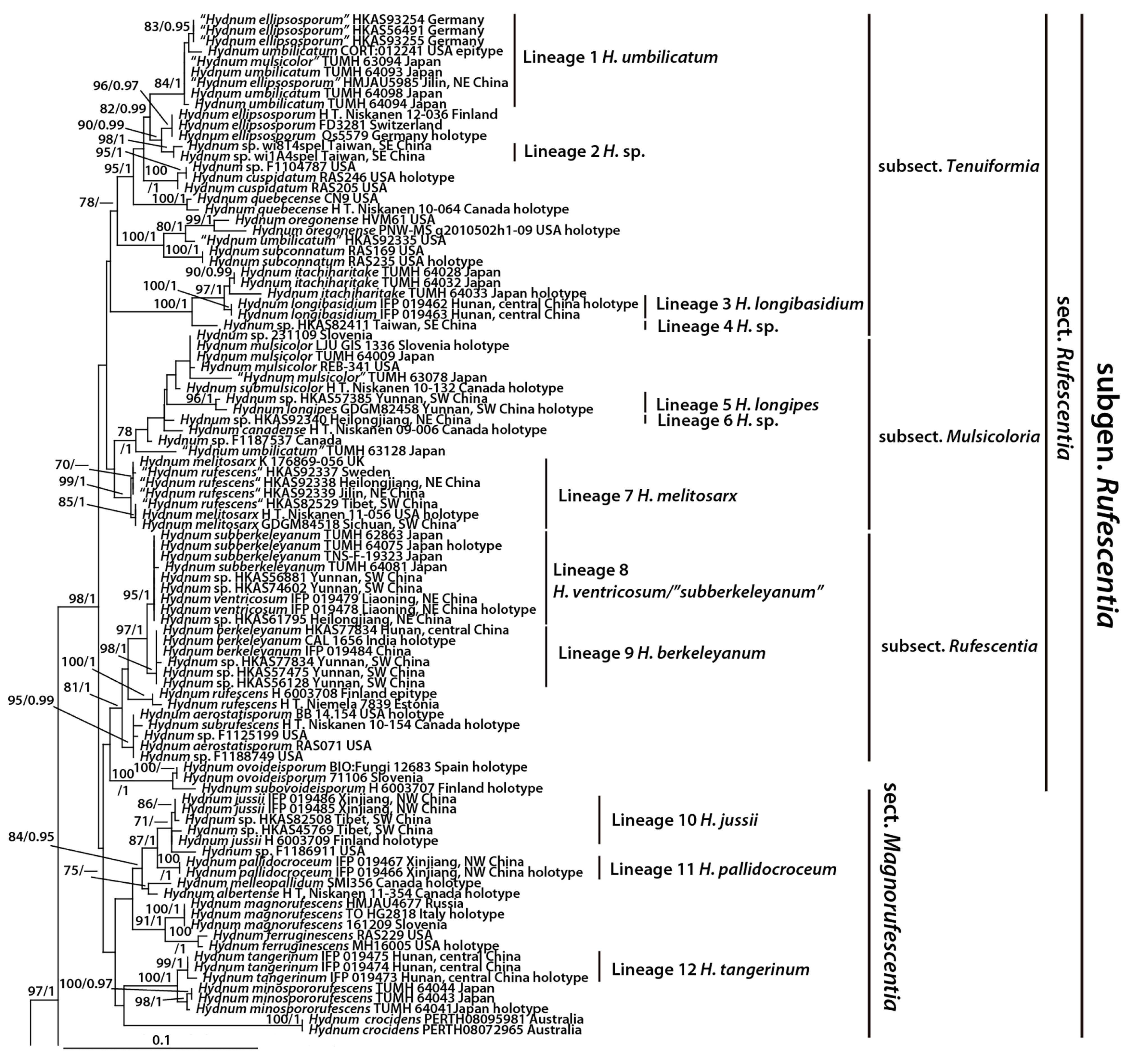
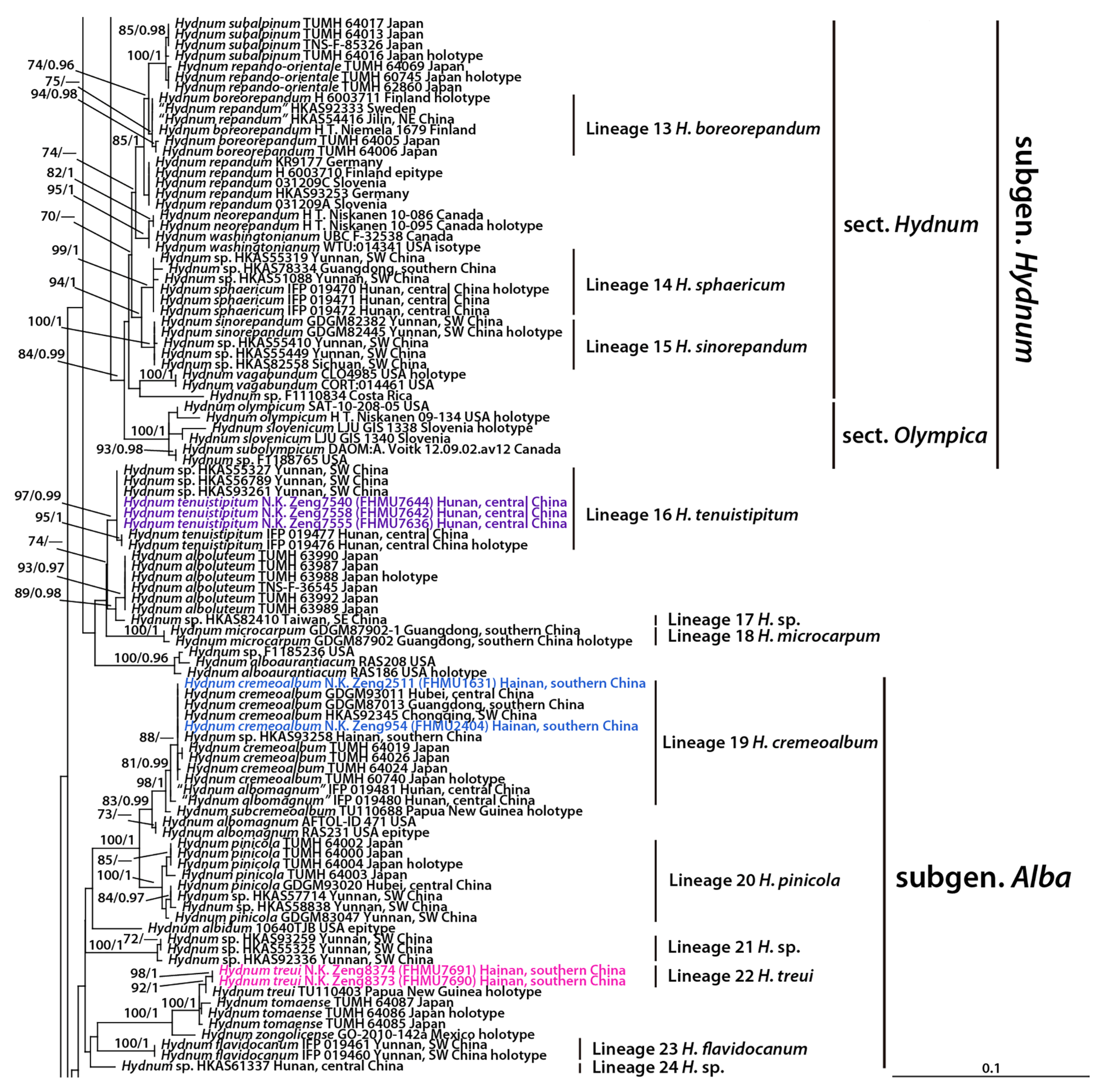

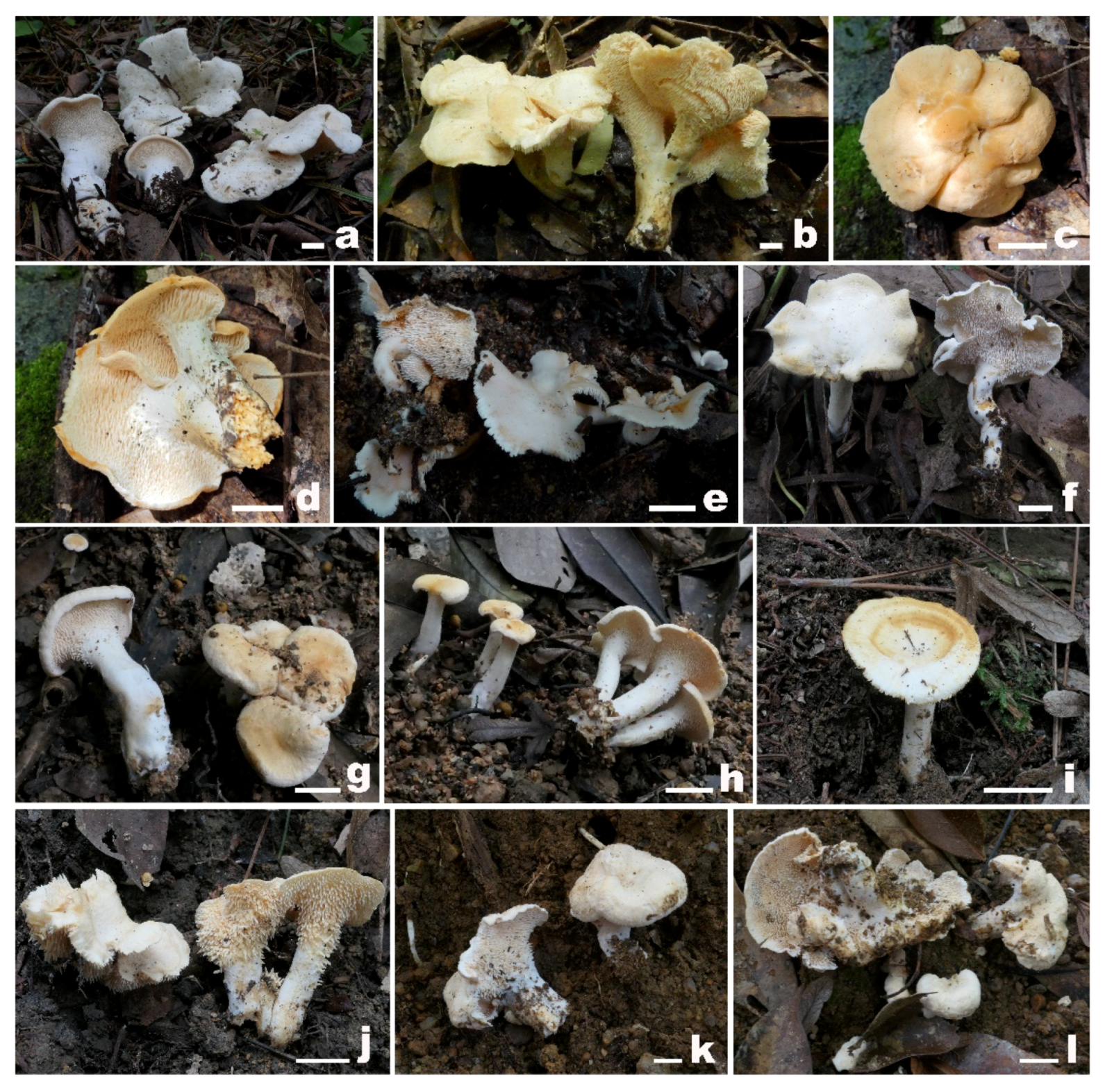
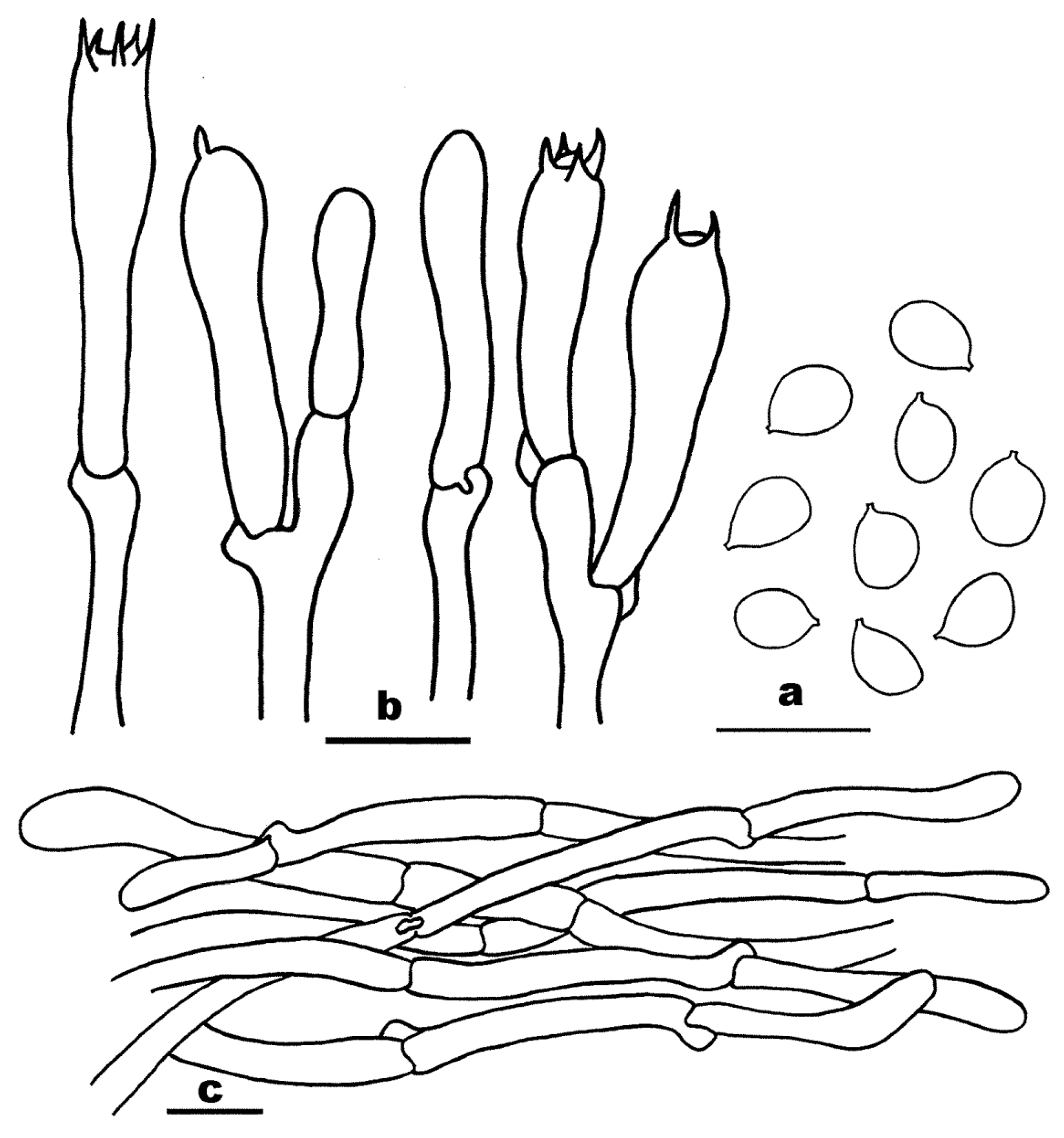
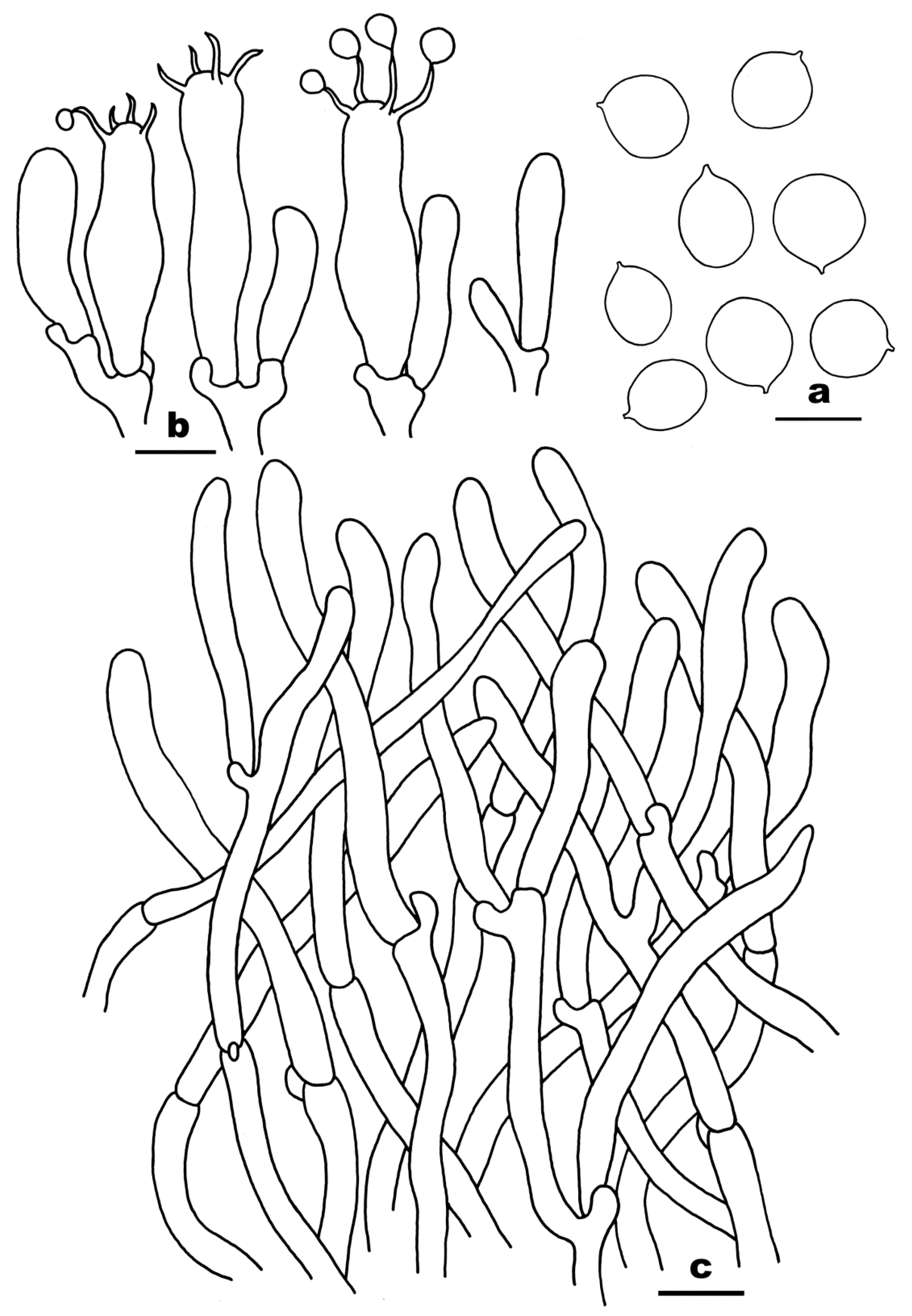
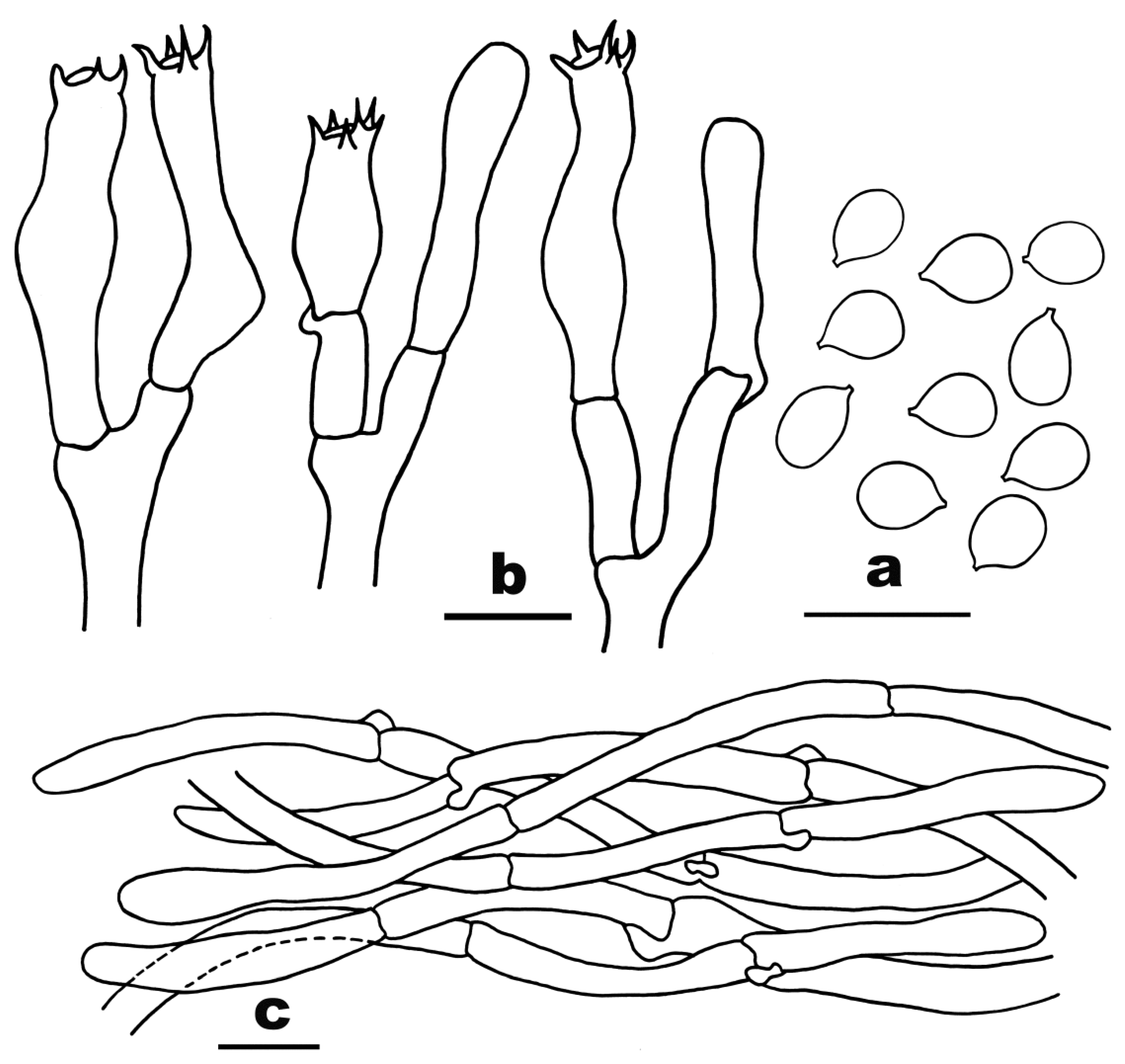
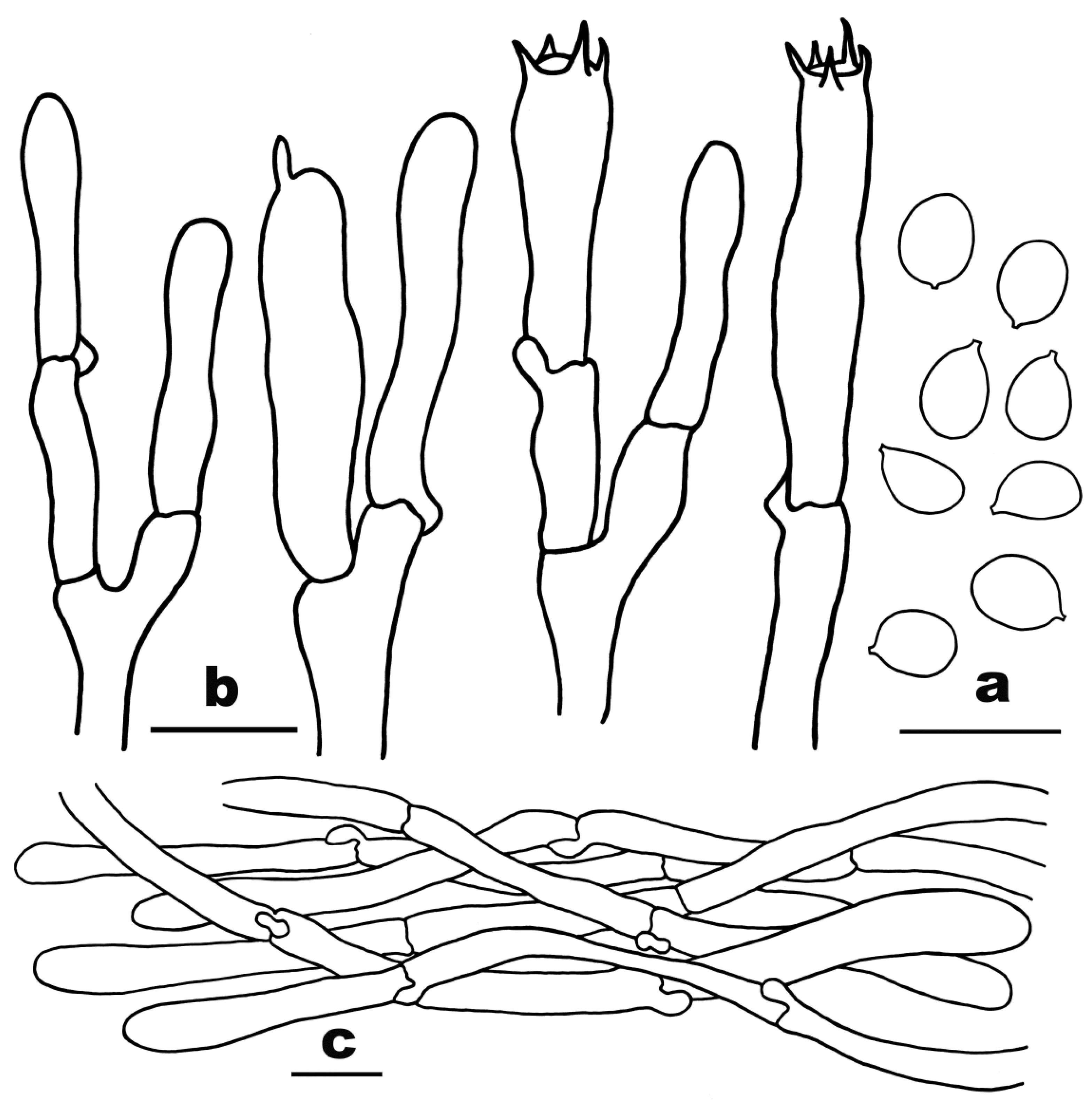

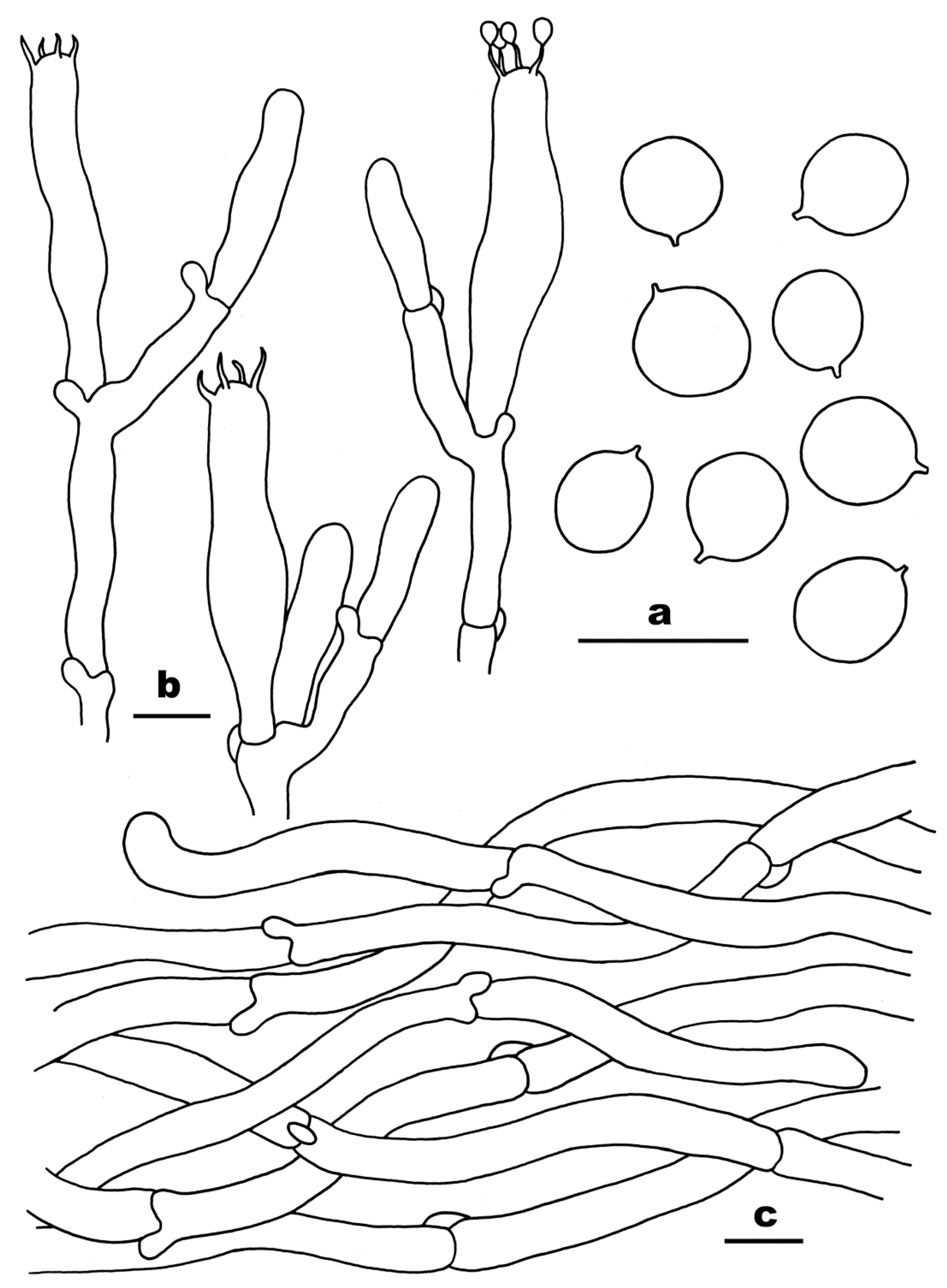
| Taxon | Voucher | Locality | GenBank/UNITE Accession Nos. | References | |
|---|---|---|---|---|---|
| 28S | ITS | ||||
| Hydnum aerostatisporum | BB 14.154 | USA | — | KY800343 | [18] |
| H. aerostatisporum | RAS071 | USA | — | MH379885 | [4] |
| H. albertense | H T. Niskanen 11-354 | Canada | — | KX388664 | [1] |
| H. albidum | 10640TJB | USA | — | MH379883 | [4] |
| H. alboaurantiacum | RAS186 | USA | — | MH379955 | [4] |
| H. alboaurantiacum | RAS208 | USA | — | MH379937 | [4] |
| H. alboluteum | TNS-F-36545 | Japan | — | LC621797 | [14] |
| H. alboluteum | TUMH 63987 | Japan | — | LC621801 | [14] |
| H. alboluteum | TUMH 63988 | Japan | — | LC621802 | [14] |
| H. alboluteum | TUMH 63989 | Japan | — | LC621803 | [14] |
| H. alboluteum | TUMH 63990 | Japan | — | LC621804 | [14] |
| H. alboluteum | TUMH 63992 | Japan | — | LC621805 | [14] |
| H. albomagnum | AFTOL-ID 471 | USA | AY700199 | DQ218305 | [42] |
| H. albomagnum | RAS231 | USA | — | MH379943 | [4] |
| “H. albomagnum” | IFP 019480 | Hunan, central China | MW979536 | MW980550 | [15] |
| “H. albomagnum” | IFP 019481 | Hunan, central China | MW979537 | MW980551 | [15] |
| H. albopallidum | TUMH 63997 | Japan | LC717904 | LC621807 | [14] |
| H. albopallidum | TUMH 63998 | Japan | — | LC621808 | [14] |
| H. albopallidum | TUMH 63999 | Japan | — | LC621809 | [14] |
| H. berkeleyanum | CAL 1656 | India | NG_070500 | NR_158533 | [43] |
| H. berkeleyanum | HKAS77834 | Hunan, SC China | KU612667 | KU612525 | [9] |
| H. berkeleyanum | IFP 019484 | China | MW979538 | MW980552 | [15] |
| H. boreorepandum | H T. Niemela 1679 | Finland | — | KX388658 | [1] |
| H. boreorepandum | H 6003711 | Finland | — | KX388657 | [1] |
| H. boreorepandum | TUMH 64005 | Japan | LC717880 | LC621814 | [14,44] |
| H. boreorepandum | TUMH 64006 | Japan | LC717881 | LC621815 | [14,44] |
| H. brevispinum | IFP 019464 | Hunan, central China | MW979559 | MW980578 | [15] |
| H. brevispinum | IFP 019465 | Hunan, central China | MW979560 | MW980579 | [15] |
| H. canadense | H T. Niskanen 09-006 | Canada | — | KX388681 | [1] |
| H. cremeoalbum | GDGM87013 | Guangdong, southern China | OR947135 | OR947126 | [22] |
| H. cremeoalbum | GDGM93011 | Hubei, central China | OR947129 | OR947110 | [22] |
| H. cremeoalbum | TUMH60740 | Japan | — | AB906678 | [5] |
| H. cremeoalbum | HKAS92345 | Chongqing, SW China | KU612676 | KU612619 | [9] |
| H. cremeoalbum | TUMH 64024 | Japan | LC717912 | LC621823 | [14,44] |
| H. cremeoalbum | TUMH 64019 | Japan | — | LC621820 | [14] |
| H. cremeoalbum | TUMH 64026 | Japan | — | LC621825 | [14] |
| H. cremeoalbum | N.K. Zeng954 (FHMU2404) | Hainan, southern China | OQ656791 | — | Present study |
| H. cremeoalbum | N.K. Zeng2511 (FHMU1631) | Hainan, southern China | OQ656792 | OQ656784 | Present study |
| H. crocidens | PERTH08072965 | Australia | KU612685 | KU612630 | [9] |
| H. crocidens | PERTH08095981 | Australia | KU612684 | KU612631 | [9] |
| H. cuspidatum | RAS246 | USA | — | MH379944 | [4] |
| H. cuspidatum | RAS205 | USA | — | MH379936 | [4] |
| H. erectum | gui0024 (FHMU7689) | Zhejiang, eastern China | OR722669 | OR722666 | Present study |
| “H. ellipsosporum” | HMJAU5985 | Jilin, NE China | — | KU612602 | [9] |
| H. ellipsosporum | HKAS93254 | Germany | — | KU612604 | [9] |
| “H. ellipsosporum” | HKAS93255 | Germany | — | KU612605 | [9] |
| “H. ellipsosporum” | HKAS56491 | Germany | — | KU612603 | [9] |
| “H. ellipsosporum” | Os5579 | Germany | — | AY817138 | [11] |
| H. ellipsosporum | H T. Niskanen 12-036 | Finland | — | KX388671 | [1] |
| H. ellipsosporum | FD3281 | Switzerland | KX086217 | KX086215 | Unpublished |
| H. ferruginescens | MH16005 | USA | — | MH379905 | [4] |
| H. ferruginescens | RAS229 | USA | — | MH379942 | [4] |
| H. flabellatum | IFP 019459 | Liaoning, NE China | MW979556 | MW980575 | [15] |
| H. flavidocanum | IFP 019460 | Yunnan, SW China | MW979545 | MW980559 | [15] |
| H. flavidocanum | IFP 019461 | Yunnan, SW China | MW979546 | MW980560 | [15] |
| H. ibericum | BIO:Fungi:12330 | Spain | — | HE611086 | [17] |
| H. ibericum | MA-fungi 3457 | Spain | — | AJ547879 | [12] |
| H. itachiharitake | TUMH 64032 | Japan | LC717905 | LC621829 | [14,44] |
| H. itachiharitake | TUMH 64028 | Japan | — | LC621827 | [14] |
| H. itachiharitake | TUMH 64033 | Japan | — | LC621830 | [14] |
| H. jussii | H 6003709 | Finland | — | KX388665 | [1] |
| H. jussii | IFP 019485 | Xinjiang, NW China | MW979539 | MW980553 | [15] |
| H. jussii | IFP 019486 | Xinjiang, NW China | MW979540 | MW980554 | [15] |
| H. longibasidium | IFP 019462 | Hunan, central China | MW979541 | MW980556 | [15] |
| H. longibasidium | IFP 019463 | Hunan, central China | MW979542 | MW980555 | [15] |
| H. longipes | GDGM82458 | Yunnan, SW China | — | OR947121 | [22] |
| H. magnorufescens | HMJAU4677 | Russia | — | KU612550 | [9] |
| H. magnorufescens | 161209 | Slovenia | KU612669 | KU612549 | [9] |
| H. magnorufescens | TO HG2818 | Italy | — | KC293545 | [16] |
| H. melitosarx | GDGM84518 | Sichuan, SW China | OR947136 | OR947117 | [22] |
| H. melitosarx | H T. Niskanen 11-056 | USA | — | KX388683 | [1] |
| H. melitosarx | K 176869 | UK | — | KX388685 | [1] |
| H. melleopallidum | SMI356 | Canada | — | FJ845406 | [14] |
| H. microcarpum | GDGM87902 | Guangdong, southern China | OR947134 | OR947116 | [22] |
| H. microcarpum | GDGM87902-1 | Guangdong, southern China | — | OR947115 | [22] |
| H. minospororufescens | TUMH 64041 | Japan | — | LC621837 | [14] |
| H. minospororufescens | TUMH 64043 | Japan | — | LC621838 | [14] |
| H. minospororufescens | TUMH 64044 | Japan | — | LC621839 | [14] |
| H. minus | TUMH60737 | Japan | AB906675 | [5] | |
| H. minus | IFP 019482 | Hunan, central China | MW979543 | MW980557 | [15] |
| H. minus | IFP 019483 | Hunan, central China | MW979544 | MW980558 | [15] |
| H. minus | TUMH 64050 | Japan | LC717910 | LC621842 | [14,44] |
| H. minus | TUMH 63123 | Japan | — | LC377881 | [14] |
| H. minus | TUMH 64046 | Japan | — | LC621840 | [14] |
| H. minus | N.K. Zeng2819 (FHMU1798) | Yunnan, SW China | KY407528 | KY407533 | [45] |
| H. minus | N.K. Zeng1062 (FHMU2408) | Hainan, southern China | OQ656793 | OQ656785 | Present study |
| H. minus | N.K. Zeng1067 (FHMU7603) | Hainan, southern China | — | OQ656786 | Present study |
| H. mulsicolor | LJU GIS 1336 | Slovenia | — | AJ547885 | [12] |
| H. mulsicolor | REB-341 | USA | — | JX093560 | [46] |
| “H. mulsicolor” | TUMH 63094 | Japan | LC717911 | LC377892 | [19,44] |
| “H. mulsicolor” | TUMH 63078 | Japan | — | LC377890 | [19] |
| H. mulsicolor | TUMH 64009 | Japan | — | LC621843 | [14] |
| H. neorepandum | H T. Niskanen 10-095 | Canada | — | KX388659 | [1] |
| H. neorepandum | H T. Niskanen 10-086 | Canada | — | KX388660 | [1] |
| H. olympicum | H T. Niskanen 09-134 | USA | — | KX388661 | [1] |
| H. olympicum | SAT-10-208-05 | USA | — | MT955159 | Unpublished |
| H. oregonense | HVM61 | USA | — | KF879509 | [47] |
| H. oregonense | PNW-MS g2010502h1-09 | USA | — | AJ534972 | [12] |
| H. orientalbidum | GDGM93480 | Chongqing, SW China | OR947127 | OR947108 | [22] |
| H. orientalbidum | GDGM91301 | Zhejiang, eastern China | OR947130 | OR947111 | [22] |
| H. orientalbidum | TUMH 62998 | Japan | LC717908 | LC377875 | [19,44] |
| H. orientalbidum | TNS-F-35220 | Japan | — | LC621845 | [14] |
| H. orientalbidum | TNS-F-3783 | Japan | — | LC621846 | [14] |
| H. orientalbidum | TUMH 62997 | Japan | — | LC377874 | [14] |
| H. orientalbidum | N.K. Zeng5307 (FHMU6327) | Hainan, southern China | OQ656794 | OQ656787 | Present study |
| H. orientalbidum | N.K. Zeng5308 (FHMU6361) | Hainan, southern China | OQ656795 | OQ656788 | Present study |
| H. orientalbidum | N.K. Zeng5309 (FHMU3153) | Hainan, southern China | OQ656796 | OQ656789 | Present study |
| H. ovoideisporum | BIO:Fungi 12683 | Spain | — | NR_119818 | [48] |
| H. ovoideisporum | 71106 | Slovenia | — | KU612536 | [9] |
| H. pallidocroceum | IFP 019466 | Xinjiang, NW China | MW979554 | MW980568 | [15] |
| H. pallidocroceum | IFP 019467 | Xinjiang, NW China | MW979555 | MW980569 | [15] |
| H. pallidomarginatum | IFP 019468 | Yunnan, SW China | MW979552 | MW980566 | [15] |
| H. pallidomarginatum | IFP 019469 | Yunnan, SW China | MW979553 | MW980567 | [15] |
| H. pinicola | GDGM93020 | Hubei, central China | OR947128 | OR947109 | [22] |
| H. pinicola | GDGM83047 | Yunnan, SW China | OR947137 | OR947119 | [22] |
| H. pinicola | TUMH 64000 | Japan | — | LC621810 | [14] |
| H. pinicola | TUMH 64002 | Japan | — | LC621811 | [14] |
| H. pinicola | TUMH 64003 | Japan | — | LC621812 | [14] |
| H. pinicola | TUMH 64004 | Japan | — | LC621813 | [14] |
| H. quebecense | H T. Niskanen 10-064 | Canada | — | KX388662 | [1] |
| H. quebecense | CN9 | USA | — | MH379881 | [4] |
| H. repando-orientale | TUMH60745 | Japan | — | AB906683 | [5] |
| H. repando-orientale | TUMH 62860 | Japan | LC717900 | LC377883 | [19,44] |
| H. repando-orientale | TUMH 64069 | Japan | LC717903 | LC621873 | [14,44] |
| H. repandum | KR9177 | Germany | — | KU612575 | [9] |
| H. repandum | HKAS93253 | Germany | — | KU612581 | [9] |
| H. repandum | 031209C | Slovenia | — | KU612576 | [9] |
| H. repandum | 031209A | Slovenia | KU612655 | KU612574 | [9] |
| “H. repandum” | HKAS54416 | Jilin, NE China | — | KU612583 | [9] |
| “H. repandum” | HKAS92333 | Sweden | — | KU612582 | [9] |
| “H. repandum” | 420526MF0925 | Hubei, central China | MH141377 | — | Unpublished |
| H. repandum | H 6003710 | Finland | — | NR_164553 | [1] |
| “H. rufescens” | HKAS92339 | Jilin, NE China | KU612658 | KU612537 | [9] |
| H. rufescens | HKAS92338 | Heilongjiang, NE China | KU612659 | KU612538 | [9] |
| “H. rufescens” | HKAS82529 | Tibet, SW China | KU612657 | KU612541 | [9] |
| “H. rufescens” | HKAS92337 | Sweden | KU612656 | KU612539 | [9] |
| H. rufescens | H 6003708 | Finland | — | KX388688 | [1] |
| H. rufescens | H T. Niemela 7839 | Estonia | — | KX388656 | [1] |
| H. sinorepandum | GDGM82445 | Yunnan, SW China | OR947139 | OR947122 | [22] |
| H. sinorepandum | GDGM82382 | Yunnan, SW China | OR947141 | OR947124 | [22] |
| H. slovenicum | LJU GIS 1338 | Slovenia | — | AJ547870 | [12] |
| H. slovenicum | LJU GIS 1340 | Slovenia | — | AJ547884 | [12] |
| H. sp. | F1110834 | Costa Rica | — | KU612598 | [9] |
| H. sp. | F1104787 | USA | — | KU612606 | [9] |
| H. sp. | FRI62832 | Malaysia | — | KU612625 | [9] |
| H. sp. | HKAS57385 | Yunnan, SW China | — | KU612601 | [9] |
| H. sp. | HKAS61337 | Hunan, central China | KU612644 | KU612597 | [9] |
| H. sp. | HKAS82411 | Taiwan, SE China | KU612668 | KU612607 | [9] |
| H. sp. | TM070 | Canada | DQ898744 | — | [3] |
| H. sp. | wi1A4spel | Taiwan, SE China | — | KC679833 | Unpublished |
| H. sp. | wi8T4spel | Taiwan, SE China | — | KC679834 | Unpublished |
| H. sp. | 231109 | Slovenia | KU612660 | KU612545 | [9] |
| H. sp. | F1187537 | Canada | KU612544 | [9] | |
| H. sp. | HKAS92340 | Heilongjiang, NE China | KU612661 | KU612543 | [9] |
| H. sp. | HKAS56128 | Yunnan, SW China | — | KU612526 | [9] |
| H. sp. | HKAS56881 | Yunnan, SW China | — | KU612530 | [9] |
| H. sp. | HKAS57475 | Yunnan, SW China | KU612666 | KU612528 | [9] |
| H. sp. | HKAS61795 | Heilongjiang, NE China | KU612665 | KU612531 | [9] |
| H. sp. | HKAS77834 | Yunnan, SW China | KU612667 | KU612525 | [9] |
| H. sp. | HKAS74602 | Yunnan, SW China | — | KU612532 | [9] |
| H. sp. | F1125199 | USA | — | KU612534 | [9] |
| H. sp. | F1188749 | USA | KU612663 | KU612535 | [9] |
| H. sp. | F1186911 | USA | KU612662 | KU612548 | [9] |
| H. sp. | HKAS82508 | Tibet, SW China | KU612670 | KU612546 | [9] |
| H. sp. | HKAS45769 | Tibet, SW China | — | KU612547 | [9] |
| H. sp. | HKAS55319 | Yunnan, SW China | — | KU612590 | [9] |
| H. sp. | HKAS51088 | Yunnan, SW China | — | KU612587 | [9] |
| H. sp. | HKAS78334 | Guangdong, southern China | — | KU612589 | [9] |
| H. sp. | HKAS55410 | Yunnan, SW China | KU612654 | KU612596 | [9] |
| H. sp. | HKAS55449 | Yunnan, SW China | — | KU612594 | [9] |
| H. sp. | HKAS82558 | Sichuan, SW China | — | KU612595 | [9] |
| H. sp. | F1188765 | USA | KU612653 | KU612599 | [9] |
| H. sp. | HKAS55327 | Yunnan, SW China | KU612682 | KU612568 | [9] |
| H. sp. | HKAS56789 | Yunnan, SW China | KU612680 | KU612571 | [9] |
| H. sp. | HKAS82410 | Taiwan, SE China | KU612679 | KU612573 | [9] |
| H. sp. | HKAS93261 | Yunnan, SW China | KU612681 | KU612567 | [9] |
| H. sp. | F1185236 | USA | — | KU612600 | [9] |
| H. sp. | HKAS93258 | Hainan, southern China | KU612677 | KU612618 | [9] |
| H. sp. | HKAS92345 | Chongqing, SW China | KU612676 | KU612619 | [9] |
| H. sp. | HKAS57714 | Yunnan, SW China | KU612673 | KU612617 | [9] |
| H. sp. | HKAS58838 | Yunnan, SW China | KU612675 | KU612616 | [9] |
| H. sp. | HKAS55325 | Yunnan, SW China | — | KU612613 | [9] |
| H. sp. | HKAS93259 | Yunnan, SW China | KU612683 | KU612612 | [9] |
| H. sp. | HKAS92336 | Yunnan, SW China | — | KU612614 | [9] |
| H. sp. | HKAS52807 | Yunnan, SW China | — | KU612609 | [9] |
| H. sp. | HKAS92350 | Guizhou, SW China | KU612672 | KU612610 | [9] |
| H. sp. | HKAS92347 | Chongqing, SW China | KU612652 | — | [9] |
| H. sp. | HKAS92349 | Guizhou, SW China | KU612671 | — | [9] |
| H. sp. | TUMH 64099 | Japan | — | LC621899 | [14] |
| H. sp. | TUMH 64100 | Japan | — | LC621900 | [14] |
| H. sphaericum | IFP 019470 | Hunan, central China | MW979549 | MW980563 | [15] |
| H. sphaericum | IFP 019471 | Hunan, central China | MW979551 | MW980565 | [15] |
| H. sphaericum | IFP 019472 | Hunan, central China | MW979550 | MW980564 | [15] |
| H. subalpinum | TUMH 64013 | Japan | LC717888 | LC717913 | [44] |
| H. subalpinum | TUMH 64016 | Japan | LC717891 | LC621871 | [14,44] |
| H. subalpinum | TUMH 64017 | Japan | LC717892 | LC621872 | [14,44] |
| H. subalpinum | TNS-F-85326 | Japan | LC717885 | LC621866 | [14,44] |
| H. subcremeoalbum | TU110688 | Papua New Guinea | — | UDB013289 * | [1] |
| “H. subberkeleyanum” | TNS-F-19323 | Japan | — | LC621879 | [14] |
| “H. subberkeleyanum” | TUMH 62863 | Japan | — | LC377889 | [14] |
| “H. subberkeleyanum” | TUMH 64075 | Japan | — | LC621881 | [14] |
| “H. subberkeleyanum” | TUMH 64081 | Japan | — | LC621882 | [14] |
| H. subconnatum | RAS235 | USA | — | MH379930 | [4] |
| H. subconnatum | RAS169 | USA | — | MH379916 | [4] |
| H. submulsicolor | H T. Niskanen 10-132 | Canada | — | KX388682 | [1] |
| H. subolympicum | DAOM:A. Voitk 12.09.02.av12 | Canada | — | MH174257 | [1] |
| H. subovoideisporum | H 6003707 | Finland | — | NR_158494 | [1] |
| H. subrufescens | H T. Niskanen 10-154 | Canada | — | KX388649 | [1] |
| H. subtilior | RAS180 | USA | — | MH379918 | [4] |
| H. subtilior | TENN 073034 | USA | — | NR_164029 | [4] |
| H. tangerinum | IFP 019473 | Hunan, central China | MW979561 | MW980580 | [15] |
| H. tangerinum | IFP 019474 | Hunan, central China | MW979562 | MW980581 | [15] |
| H. tangerinum | IFP 019475 | Hunan, central China | MW979563 | MW980582 | [15] |
| H. tenuistipitum | IFP 019476 | Hunan, central China | MW979557 | MW980576 | [15] |
| H. tenuistipitum | IFP 019477 | Hunan, central China | MW979558 | MW980577 | [15] |
| H. tenuistipitum | N.K. Zeng7540 (FHMU7644) | Hunan, central China | OQ913756 | OQ913759 | Present study |
| H. tenuistipitum | N.K. Zeng7555 (FHMU7636) | Hunan, central China | OQ913757 | OQ913760 | Present study |
| H. tenuistipitum | N.K. Zeng7558 (FHMU7642) | Hunan, central China | OQ913758 | OQ913761 | Present study |
| H. tomaense | TUMH 64086 | Japan | LC717907 | LC621885 | [14,44] |
| H. tomaense | TUMH 64085 | Japan | — | LC621884 | [14] |
| H. tomaense | TUMH 64087 | Japan | — | LC621886 | [14] |
| H. tottoriense | TUMH 64090 | Japan | — | LC621889 | [14] |
| H. tottoriense | TUMH 64091 | Japan | — | LC621890 | [14] |
| H. tottoriense | TUMH 64092 | Japan | — | LC621891 | [14] |
| H. treui | TU110403 | Papua New Guinea | — | UDB013043 * | [1] |
| H. treui | N.K. Zeng8373 (FHMU7690) | Hainan, southern China | OR722670 | OR722667 | Present study |
| H. treui | N.K. Zeng8374 (FHMU7691) | Hainan, southern China | OR722671 | OR722668 | Present study |
| H. umbilicatum | CORT:012241 | USA | — | MH379890 | [4] |
| “H. umbilicatum” | HKAS92335 | USA | KU612678 | KU612608 | [9] |
| “H. umbilicatum” | TUMH 63128 | Japan | LC717909 | LC377891 | [19,44] |
| H. umbilicatum | TUMH 64093 | Japan | — | LC621893 | [14] |
| H. umbilicatum | TUMH 64094 | Japan | — | LC621894 | [14] |
| H. umbilicatum | TUMH 64098 | Japan | — | LC621898 | [14] |
| H. vagabundum | CLO4985 | USA | — | MH379909 | [4] |
| H. vagabundum | CORT:014461 | USA | — | MH379949 | [4] |
| H. ventricosum | IFP 019478 | Liaoning, NE China | MW979547 | MW980561 | [9] |
| H. ventricosum | IFP 019479 | Liaoning, NE China | MW979548 | MW980562 | [9] |
| H. vesterholtii | BIO:Fungi:10429 | Spain | — | HE611084 | [9] |
| H. vesterholtii | BIO:Fungi:10452 | Spain | — | HE611085 | [9] |
| H. vesterholtii | BIO:Fungi:12904 | France | — | HE611087 | [9] |
| “H. vesterholtii” | HKAS56213 | Yunnan, SW China | — | KU612554 | [9] |
| “H. vesterholtii” | HKAS55399 | Yunnan, SW China | — | KU612555 | [9] |
| “H. vesterholtii” | HKAS57047 | Yunnan, SW China | — | KU612558 | [9] |
| “H. vesterholtii” | HKAS58734 | Yunnan, SW China | — | KU612559 | [9] |
| “H. vesterholtii” | HKAS51086 | Yunnan, SW China | KU612650 | KU612557 | [9] |
| “H. vesterholtii” | HKAS92341 | Shaanxi, NW China | KU612647 | KU612562 | [9] |
| “H. vesterholtii” | HKAS92342 | Yunnan, SW China | KU612646 | KU612564 | [9] |
| “H. vesterholtii” | HKAS92343 | Sichuan, SW China | KU612648 | KU612563 | [9] |
| “H. vesterholtii” | HKAS92344 | Heilongjiang, NE China | KU612649 | KU612556 | [9] |
| “H. vesterholtii” | HKAS77884 | Hunan, central China | KU612645 | KU612565 | [9] |
| “H. vesterholtii” | HKAS56489 | Germany | — | KU612561 | [9] |
| “H. vesterholtii” | HKAS92351 | Guizhou, SW China | KU612651 | — | [9] |
| H. washingtonianum | UBC F-32538 | Canada | — | MF954990 | Unpublished |
| H. washingtonianum | WTU:014341 | USA | — | MH379846 | [4] |
| H. zongolicense | GO-2010-142a | Mexico | — | KC152121 | [1] |
| Sistotrema muscicola | taxon:154757 | Finland | AJ606041 | AJ606041 | [49] |
| S. muscicola | KHL 11721 | Finland | AJ606040 | AJ606040 | [49] |
| Subgenus | Section | Subsection | Species | Locality | References |
|---|---|---|---|---|---|
| Alba Niskanen & Liimat. | — | — | H. cremeoalbum | Japan | [5] |
| H. flavidocanum | Yunnan, SW China | [15] | |||
| H. pinicola | Japan | [14] | |||
| H. treui | Papua New Guinea | [1] | |||
| Brevispina T. Cao & H. S. Yuan | — | — | H. brevispinum | Hunan, central China | [15] |
| H. minus | Japan | [5] | |||
| Hydnum L. | Hydnum L. | — | H. sinorepandum | Yunnan Province, SW China | [22] |
| H. sphaericum | Hunan, central China | [15] | |||
| Pallida Niskanen & Liimat. | — | — | H. erectum | Zhejiang, eastern China | Present study |
| H. flabellatum | Liaoning, NE China | [15] | |||
| H. pallidomarginatum | Yunnan, SW China | [15] | |||
| Rufescentia Niskanen & Liimat. | Magnorufescentia Niskanen & Liimat. | — | H. pallidocroceum | Xinjiang, NW China | [15] |
| H. tangerinum | Hunan, central China | [15] | |||
| Mulsicoloria Niskanen & Liimat. | H. longipes | Yunnan Province, SW China | [22] | ||
| H. melitosarx | USA | [1] | |||
| Rufescentia Niskanen & Liimat. | Rufescentia Niskanen & Liimat. | H. ventricosum | Liaoning, NE China | [15] | |
| Tenuiformia Niskanen & Liimat. | H. longibasidium | Hunan, central China | [15] | ||
| — | — | — | H. microcarpum | Guangdong Province, southern China | [22] |
| H. orientalbidum | Japan | [14] | |||
| H. tenuistipitum | Hunan, central China | [15] |
Disclaimer/Publisher’s Note: The statements, opinions and data contained in all publications are solely those of the individual author(s) and contributor(s) and not of MDPI and/or the editor(s). MDPI and/or the editor(s) disclaim responsibility for any injury to people or property resulting from any ideas, methods, instructions or products referred to in the content. |
© 2024 by the authors. Licensee MDPI, Basel, Switzerland. This article is an open access article distributed under the terms and conditions of the Creative Commons Attribution (CC BY) license (https://creativecommons.org/licenses/by/4.0/).
Share and Cite
Qin, H.-Z.; Liao, Y.-T.; Zhang, Y.-Z.; Lin, W.-F.; Yang, X.-Q.; Zeng, N.-K. A Contribution to the Knowledge of Hydnum (Hydnaceae, Cantharellales) in China, Introducing a New Taxon and Amending Descriptions of Five Known Species. Diversity 2024, 16, 166. https://doi.org/10.3390/d16030166
Qin H-Z, Liao Y-T, Zhang Y-Z, Lin W-F, Yang X-Q, Zeng N-K. A Contribution to the Knowledge of Hydnum (Hydnaceae, Cantharellales) in China, Introducing a New Taxon and Amending Descriptions of Five Known Species. Diversity. 2024; 16(3):166. https://doi.org/10.3390/d16030166
Chicago/Turabian StyleQin, Hua-Zhi, Yu-Ting Liao, Yu-Zhuo Zhang, Wen-Fei Lin, Xin-Quan Yang, and Nian-Kai Zeng. 2024. "A Contribution to the Knowledge of Hydnum (Hydnaceae, Cantharellales) in China, Introducing a New Taxon and Amending Descriptions of Five Known Species" Diversity 16, no. 3: 166. https://doi.org/10.3390/d16030166
APA StyleQin, H.-Z., Liao, Y.-T., Zhang, Y.-Z., Lin, W.-F., Yang, X.-Q., & Zeng, N.-K. (2024). A Contribution to the Knowledge of Hydnum (Hydnaceae, Cantharellales) in China, Introducing a New Taxon and Amending Descriptions of Five Known Species. Diversity, 16(3), 166. https://doi.org/10.3390/d16030166






